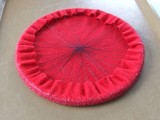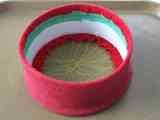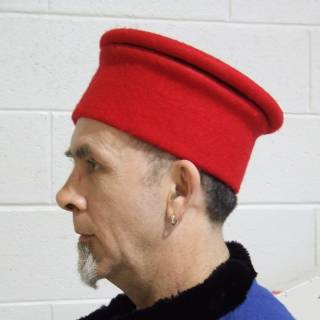
(Images
with solid
borders are clickable,
and will open a larger
image in a new
browser window.) | I
actually got this far over two years ago, intending to have it ready
for Twelfth Night. I forget exactly why I left it unfinished for so
long.
I cut out a single layer of felt in a circle, wet it,
and wrapped it around a hoop made from a length of 1/2" diameter
polyethylene tubing ("food grade", according to the label at the
hardware store). This is not the same stuff as that transparent aquarium
air hose. It's flexible enough to bend this much, and still have a
fairly rigid form. I carved out a little wooden plug, about 1/2" long,
or maybe a bit less, to join the two ends together in a smooth arc. The
plug kept it from forming a teardrop shape.
I ran
a needle and some black thread back and forth through the edge of the
circle and drew it tight to pull the edge towards the middle.
I
brushed the undiluted white glue on the outside fairly liberally, but
not right up to the edge of the felt, with the notion that I'd be
wanting to sew it to the lower section. I'm not sure (now) that I
shouldn't have applied the glue right up to the edge. (More on this
later)
I allowed it to dry overnight, right side up,
with the threads resting on top of a bowl or something, in order to
keep the rim from touching anything. |
 | Molding the inner layer of the lower section, shown here upside down. (Details of the molding form later.)
I
brought the two ends of the band of felt together, as if to fold
it, and whipstitched them together with matching thread. I opened it up
into a cylinder, and flattened the seam so that the ends were
butt-joined, with no overlap. It took a few experiments with some felt
scraps to see how close I could get to the edge without having it shred
apart when I flattened it out and pulled it.
I soaked the felt
in water, and squeezed out the excess water, then pulled it over the
form, with more-or-less the same amount of extra felt around the top
and bottom. (to be continued) |



